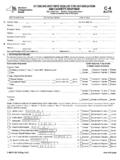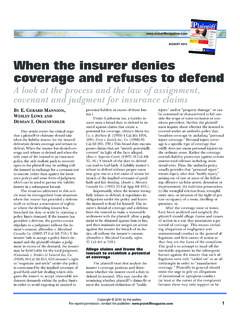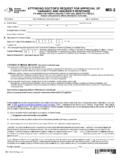Transcription of Digital distribution in insurance - THE DIGITAL INSURER
1 No 2 /2014 DIGITAL distribution in insurance :a quiet revolution01 Executive summary02 An evolving distribution landscape07 insurance on the Web17 Mobile devices24 Potential role of Big Data in distribution30 Strategic implications for insurers: threats, opportunities and challenges37 ConclusionSwiss Re sigma No 2/2014 1 Executive summaryTechnological innovations are breaking up the traditional insurance distribution process and re-configuring standard intermediary functions. distribution has progressively broadened from an own-sales force versus agent/broker paradigm to a wide variety of direct and indirect channels between insurers and existing and potential newest direct sales channels the internet and mobile devices currently command a small portion of the market in terms of premiums. Agents and brokers, and other intermediaries such as retailers, banks and affinity groups continue to dominate sales.
2 However, the statistics on e-commerce insurance mask the impact new technologies have already had on the overall distribution internet is fundamentally affecting customer buying behaviour, from preliminary insurance information search to other pre-sales activity such as soliciting advice and obtaining personalised quotes, to policy issuance and post-sales services for the policyholder. Likewise, mobile technology and telematics are changing both the location and timing of interactions between insurers and their customers, allowing the retrieval and dissemination of information from almost anywhere at any in distribution are also facilitating access to a rich source of data about customers and fostering advances in predictive analytics, collectively labelled Big Data. These developments have the potential to radically alter the way in which insurance is designed, priced and sold.
3 Many insurers are starting to explore Big Data initiatives. However, the applications are largely preliminary and the expected returns from the related investment remain highly all likelihood, new technology will eventually enable customers to arrange almost all of their insurance needs through remote DIGITAL channels. This evolution of distribution will probably continue gradually, at least for the majority of business lines. Countries are at different stages of DIGITAL transformation and technical, cultural and institutional factors mean that not all will proceed along the same adjustment path and at the same pace. Yet the example of the UK motor insurance market where e-commerce sales now dominate shows how quickly consumer buying patterns can , DIGITAL transformation does not spell the end of intermediaries. Technology has spawned new types of intermediaries such as price comparison websites.
4 For traditional intermediaries, many of whom fear being squeezed out by direct sales, DIGITAL distribution need not lead to channel conflict. Customers will continue to value the personal interaction and expert advice of agents and brokers, especially for complex commercial and life and health risks. The challenge for intermediaries and insurers is therefore to adapt their business models to meet the varying needs and preferences of customers, while at the same time keeping the costs of integrating and maintaining multiple distribution channels under shifts in distribution increase transparency, empower customers and lower barriers to entry in some markets, which can lead to further commoditisation of insurance products. Successful insurers in the more price-competitive world will be those who can build trusted brands and reputations for good service. Additionally, telematics and a shift to more usage-based insurance will allow insurers to provide personalised cover and more risk-based pricing to further differentiate themselves from their innovation can help meet demand from some customer segments for targeted but limited interaction with their insurers.
5 It can also make insurance viable for low-income individuals currently underserved by insurers. However, successful innovation requires a culture that fosters experimentation and accepts failure during the design process. The key is to harness the insights from data and analytics to not only improve risk selection and pricing, but also to use the technology to make insurers products and services more customer quiet revolution is underway, with technology re-configuring the traditional insurance distribution internet and mobile devices are impacting distribution , but the overall share of e-commerce sales is still , new technology is fundamentally changing how consumers and firms interact with with Big Data these developments are prompting far-reaching changes in direction is clear: new technology will eventually enable customers to arrange most of their insurance through remote DIGITAL can still play a key role, but will need to adapt to their customers changing needs and competition intensifies, insurers with strong brands and technological know-how will road to successful innovation in distribution requires a culture that fosters experimentation and accepts failure during the design Swiss Re sigma No 2/2014An evolving distribution landscapeDistribution how products or services are delivered or more generally how companies interact with their customers is a key aspect of insurers business models.
6 Many may think of distribution as the sales channel alone, but in a broader sense distribution refers to activities beyond the actual purchase/sale transaction. For example, it includes the provision of and access to information on products and prices, negotiation between INSURER and consumer, purchase/sale completion, and beyond (See Figure 1).Source: Swiss Re Economic Research & ConsultingRole of insurance intermediariesTraditionally, specialist firms have bundled together some or all of these distribution activities and intermediated between customer and INSURER . In large part, this is because insurance markets are characterised by incomplete and asymmetric information. Prospective customers are often unaware of the full suite of insurance products available and/or the most appropriate insurance provider. On the other side, insurers cannot fully observe potential customers characteristics and behaviour when assessing and pricing the adequate level of risk coverage.
7 Intermediaries can help overcome some of these information problems, generating economic value for both customers and insurers through economies of scale and reduced co-ordination continue to dominate distribution for most insurance sectors around the world (see Figure 2).1 Traditional intermediaries account for more than 60% of insurance contracts sold, according to one recent global Direct sales in terms of premiums, including those by insurers own sales forces, typically represent less than a quarter of all insurance The discussion in this paper excludes health Bieck, Christian, Bodderas, Mareike, Maas, Peter and Schlager, Tobias. Powerful interaction points: Saying goodbye to the channel. IBM Institute for Business Value, December (2010). distribution relates not only to sales but also a wide range of additional 1 Activities in the insurance distribution processThese activities have traditionally been bundled together by specialist intermediaries such as agents and continue to play the dominant role in distribution in most insurance information searchOther pre-sales activityCompleting the purchase/salePost-sales activity Marketing Basic search/information gathering Product design Assessment of risk/underwriting Advice Personalised quote Negotiation Contract signing Policy issuance Premium payment Policy administration Claims management Risk managementSwiss Re sigma No 2/2014 3 Note: The shares of premiums for direct and intermediated insurance by region are based on simple averages of sector-wide shares for selected countries in each region.
8 In most cases, the data refer to 2011 or : National insurance associations and supervisory authorities and Swiss Re Economic Research & Consulting calculationsWidening set of available distribution channels New types of intermediaries from both within and outside insurance are nevertheless becoming more prominent, challenging the traditional agent-broker model. For example, bancassurance an arrangement in which a bank and an INSURER partner to sell insurance products, typically through the bank s branch network has become an increasingly important distribution channel in a number of countries in Europe, Latin America and Asia, especially for life insurance (see Figure 3).3 Likewise, strategic alliances between insurers and firms from other sectors such as retailers, post offices, utility companies and affinity groups have emerged as an alternative means of distributing : The shares of premiums for direct, agent/broker and bancassurance are based on simple averages of sector-wide shares for selected countries in each region.
9 In most cases, the data compare developments in 2011 against : National insurance associations/supervisory authorities and Swiss Re Economic Research & Consulting calculations3 The nature of the relationship between the INSURER and the bank can differ and includes combined manufacturer/distributor, exclusive distribution arrangements and multi distribution arrangements. For more discussion of bancassurance models, see Swiss Re, sigma No 5 2 Intermediated vs direct insurance sales, by region0%10%20%30%40%50%60%70%80%90%10 0%share of premiums, percentDirectIntermediatedDirectCentral and EasternEuropeAsiaWesternEuropeScand-inav iaNorthAmericaAfricaLatinAmericaIntermed iatedNon-lifeLifeNon-lifeLifeNon-lifeLif eNon-lifeLifeNon-lifeLifeNon-lifeLifeNon -lifeLifeAlternative intermediaries are nevertheless becoming more 3 Change in share of premiums by different sales channels by region, 2007 to 2011 25 20 1510 5051015202530percentage pointsDirectBancassuranceAgency/BrokerNo n-lifeLifeNon-lifeLifeNon-lifeLifeNon-li feLifeCentral andEastern EuropeAsiaWestern EuropeLatin AmericaDirectBancassuranceAgent /broker4 Swiss Re sigma No 2/2014An evolving distribution landscapeAt the same time.
10 New technology and shifts in consumer preferences have led to increased direct sales through channels such as telephone call centres, internet, direct mail and interactive TV. Increasingly, consumers can purchase directly from insurers without relying on the services of brokers and agents. As such, the prevailing model of insurance distribution has progressed from a simple model of own sales force versus agent/broker to one with multiple sales channels (see Figure 4).Source: Swiss Re Economic Research & ConsultingGrowing importance of multi-channel, multi-touch interaction The share of premiums accounted for by online sales or telemarketing has increased in many countries, especially in lines such as motor insurance where the nature of cover has become increasingly standardised. The UK motor insurance market in particular has been transformed by the internet (see Box: UK online motor insurance ).









